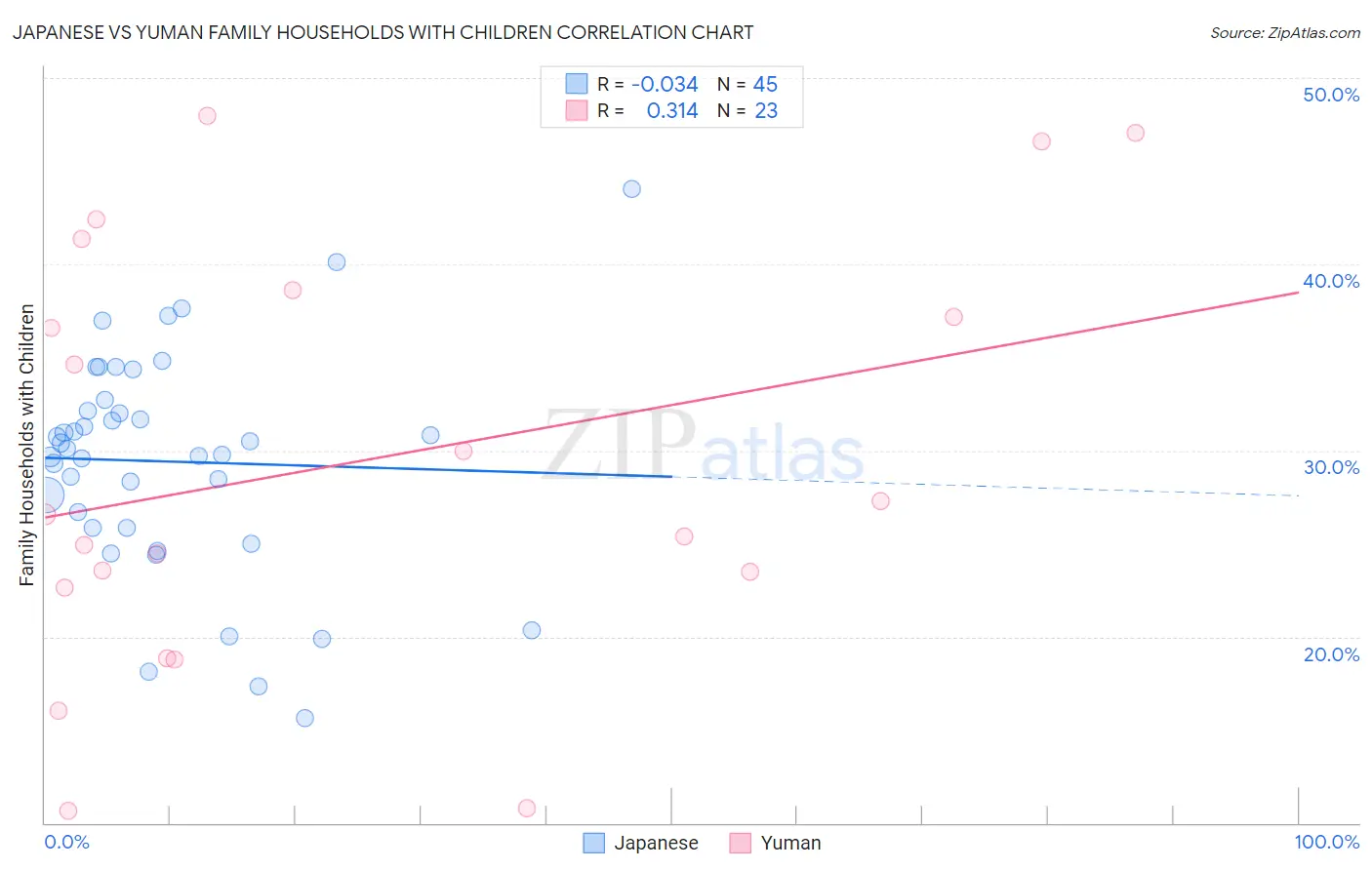Japanese vs Yuman Family Households with Children
COMPARE
Japanese
Yuman
Family Households with Children
Family Households with Children Comparison
Japanese
Yuman
29.4%
FAMILY HOUSEHOLDS WITH CHILDREN
100.0/ 100
METRIC RATING
31st/ 347
METRIC RANK
29.5%
FAMILY HOUSEHOLDS WITH CHILDREN
100.0/ 100
METRIC RATING
30th/ 347
METRIC RANK
Japanese vs Yuman Family Households with Children Correlation Chart
The statistical analysis conducted on geographies consisting of 249,052,059 people shows no correlation between the proportion of Japanese and percentage of family households with children in the United States with a correlation coefficient (R) of -0.034 and weighted average of 29.4%. Similarly, the statistical analysis conducted on geographies consisting of 40,663,391 people shows a mild positive correlation between the proportion of Yuman and percentage of family households with children in the United States with a correlation coefficient (R) of 0.314 and weighted average of 29.5%, a difference of 0.14%.

Family Households with Children Correlation Summary
| Measurement | Japanese | Yuman |
| Minimum | 15.6% | 10.6% |
| Maximum | 44.0% | 48.0% |
| Range | 28.4% | 37.4% |
| Mean | 29.4% | 29.4% |
| Median | 30.1% | 26.6% |
| Interquartile 25% (IQ1) | 25.8% | 22.6% |
| Interquartile 75% (IQ3) | 32.4% | 38.6% |
| Interquartile Range (IQR) | 6.6% | 16.0% |
| Standard Deviation (Sample) | 5.9% | 11.2% |
| Standard Deviation (Population) | 5.9% | 11.0% |
Demographics Similar to Japanese and Yuman by Family Households with Children
In terms of family households with children, the demographic groups most similar to Japanese are Immigrants from Yemen (29.4%, a difference of 0.060%), Samoan (29.5%, a difference of 0.18%), Bolivian (29.5%, a difference of 0.18%), Venezuelan (29.4%, a difference of 0.26%), and Immigrants from Bolivia (29.3%, a difference of 0.31%). Similarly, the demographic groups most similar to Yuman are Bolivian (29.5%, a difference of 0.030%), Samoan (29.5%, a difference of 0.040%), Immigrants from Vietnam (29.5%, a difference of 0.19%), Immigrants from Yemen (29.4%, a difference of 0.20%), and Sri Lankan (29.5%, a difference of 0.22%).
| Demographics | Rating | Rank | Family Households with Children |
| Immigrants | El Salvador | 100.0 /100 | #20 | Exceptional 29.8% |
| Immigrants | Laos | 100.0 /100 | #21 | Exceptional 29.8% |
| Malaysians | 100.0 /100 | #22 | Exceptional 29.8% |
| Mexican American Indians | 100.0 /100 | #23 | Exceptional 29.7% |
| Guamanians/Chamorros | 100.0 /100 | #24 | Exceptional 29.7% |
| Immigrants | Latin America | 100.0 /100 | #25 | Exceptional 29.7% |
| Sri Lankans | 100.0 /100 | #26 | Exceptional 29.5% |
| Immigrants | Vietnam | 100.0 /100 | #27 | Exceptional 29.5% |
| Samoans | 100.0 /100 | #28 | Exceptional 29.5% |
| Bolivians | 100.0 /100 | #29 | Exceptional 29.5% |
| Yuman | 100.0 /100 | #30 | Exceptional 29.5% |
| Japanese | 100.0 /100 | #31 | Exceptional 29.4% |
| Immigrants | Yemen | 100.0 /100 | #32 | Exceptional 29.4% |
| Venezuelans | 100.0 /100 | #33 | Exceptional 29.4% |
| Immigrants | Bolivia | 100.0 /100 | #34 | Exceptional 29.3% |
| Immigrants | Sierra Leone | 100.0 /100 | #35 | Exceptional 29.3% |
| Immigrants | Venezuela | 100.0 /100 | #36 | Exceptional 29.3% |
| Immigrants | Cameroon | 100.0 /100 | #37 | Exceptional 29.2% |
| Koreans | 100.0 /100 | #38 | Exceptional 29.2% |
| Yaqui | 100.0 /100 | #39 | Exceptional 29.1% |
| Central Americans | 100.0 /100 | #40 | Exceptional 29.1% |